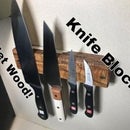Introduction: Restoring a Mini Ball Peen Hammer
So I got this small Stanley hammer in a large collection of tools and I thought it would be great to restore. A perfect little hammer for knocking in pins into knife scales.
Here’s a list of some stuff you will need.
Wire wheel for drill
Drill
Punch
Hammer
Sandpaper
Wood/metal wedge for hammer
Wd40 (or any protective oil)
Danish oil (or your favorite wood finish)
Step 1: Disassembling
For this hammer the handle was in pretty good condition (other than being loose) so I thought it would be wasteful to replace it and make a new handle. Even though the handle was in good shape the head needs to be removed so both can be easily worked on. I used a punch with the head clamped in a vice and smacked out the handle.
Step 2: Fixing the Handle
Because of the handle being in such good shape it needed minimal fixing. I first blended the hard shoulder from the old hammer head with a half round file. Then I made the cut in the handle wider so it can hold the wedge. Because the handle was rather loose I didn’t want to take a lot of material off in the top region. Then I used a razor blade like a scraper to scrape off the old varnish and dirt. A cabinet scraper would be a better option, you could also sand off the old finish if you so desire. After scraping I sanded the handle with 220 and 400 grit sandpaper. (Finial sanding will be done after head is attached)
Step 3: Cleaning the Hammer Head
The main tool I used to clean the old paint and rust off the head was a wire wheel chucked up in a drill. This can be found at any hardware store and worked really well. At first I had it in a drill press and I held the hammer head in my hand, but the hammer head was too small for me to hold and I thought it would be safer to put the head in a vice and use a hand drill. Either way works very well.
Step 4: Attaching Head to the Handle
After I tapped the head onto the handle, i turned it over and smacked the butt of the handle with a mallet which drove the head tighter to the handle. For most hammers (like this one) I used 2 wedges one wood and one metal. I split the wood wedge to the width of the eye of the hammer. I hammered the wedge into the cut in the handle until it was tight enough to the point where I didn’t think it would go in further. After snapping the wood wedge off and sanding it flush I hammered a small metal wedge perpendicular and at a slight angle to the wood wedge. At this point the handle was tight and had no wobble. If there is even a slight bit of wobble you will have to take out both wedges and try again.
Step 5: Final Finishing
After the head is attached I lightly sand the handle and apply a coat of danish oil to protect the wood. Make sure to get the coating on all exposed areas of wood. I’ll also apply a coat of wd40 to the metal to protect the head from rust.
Step 6: Time to Use the Hammer!!
I had a lot of fun fixing this hammer and it will be a handy tool around the shop. If you have any questions about hammer/ axe restorations let me know in the comments and I’ll answer them. Also make sure to check out my Instagram @bitterbladeco and the video about this hammer on my YouTube Bitter Blade Co. Thanks for following along!











